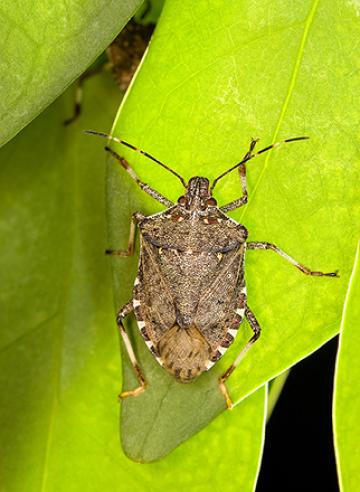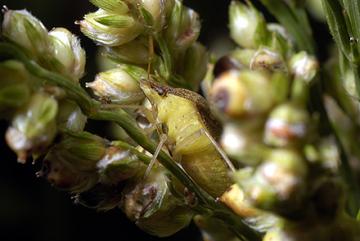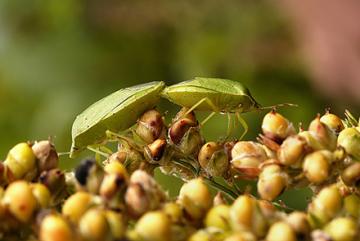Stink Bugs Face Natural Enemies
Patricia Glynn Tillman, an Agricultural Research Service entomologist in Tifton, Georgia, is focused on finding natural ways to control stink bugs in a region where the invasive brown marmorated stink bug is just one type of stink bug attacking crops. Growers there also must contend with green, southern green, and brown stink bugs.
The brown marmorated stink bug, Halyomorpha halys, is from Asia and is now in 44 U.S. states. Distinguishing marks include white bands on the antennae and legs and alternating dark and light bands at the margin of its abdomen. Crops at high risk for damage include apples, Asian pears, beans of all types, blueberries, corn, cotton, eggplant, grapes, okra, peaches, pecans, soybeans, and tomatoes.
The brown stink bug, Euschistus servus, is found throughout the United States, but is most abundant in Southeast. It attacks vegetables like beans, mustard, okra, peas, peppers, sweet corn, tomatoes, and turnips, as well as field crops such as cotton, field corn, sorghum (shown here), and soybean. It also damages fruit crops, like apples, blueberries, peaches, and plums; and nuts, such as pecans.
The southern green stink bug, Nezara viridula, is found primarily in the southeastern United States. It attacks the same crops as the brown stink bug. A mating pair is shown here on a sorghum seed head.
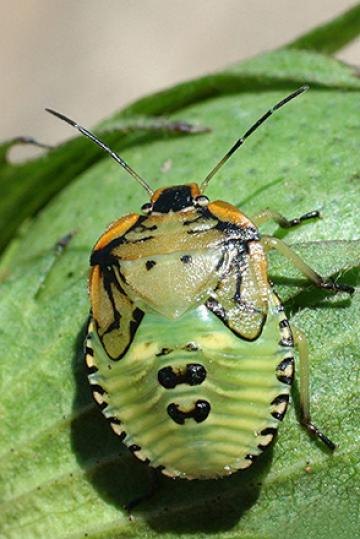
Russ Ottens, University of Georgia, Bugwood.org
The green stink bug, Chinavia hilaris, is distributed across the United States as far north as New England. It attacks apples, beans, cherries, cotton, eggplant, peaches, peas, pecans, soybeans, and tomatoes. A nymph is shown here on a cotton boll.
Tillman and her colleagues surveyed 17 sites in Alabama and Georgia once a month from May through October in 2017. They found that eight tiny nonstinging wasps, known to attack brown marmorated stink bug eggs in northeastern states, also attacked these other stink bugs in the areas surveyed. They also found two new tiny wasps attacking brown marmorated stink bug eggs.
This Trissolcus euschisti wasp (about 1.5 millimeters long), which emerged from a stink bug egg, is a promising biocontrol agent for the brown marmorated stink bug.
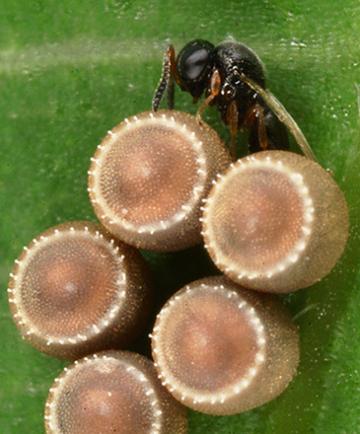
Dr. Guido Bohne, Kassel (FRG), Flickr
A Trissolcus spp. wasp on a stink bug egg mass. Several species of Trissolcus parasitize and kill eggs of stink bugs, including the brown marmorated stink bug.
—By Dennis O’Brien, ARS Office of Communications.
Tillman has shown that buckwheat and other nectar-producing plants can attract and nourish the types of beneficial wasps that control stink bugs. Providing these natural enemies of stink bugs with nectar in the spring allows them to develop in woodlands and move into the crops in the summer to parasitize stink bugs.
Stink bug-weary homeowners could use the same tactic, planting nectar-producing plants near their homes and gardens, she says.
Tillman plans to continue the surveys, adding sites in South Carolina to future counts. “These natural enemies are out there, and we need to do what we can to help them,” she says.
You May Also Like


